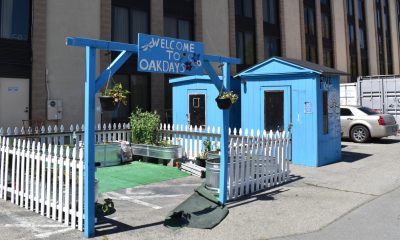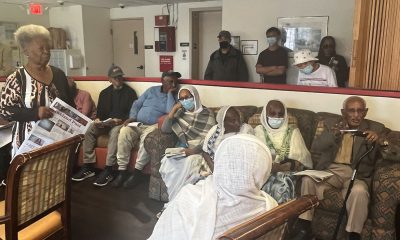Health
High Nursing Home Bills Squeeze Insurers, Driving Rates Up

In this Feb. 28, 2013, file photo, Tina Reese leads a word game for residents at a nursing home in Lancaster, Pa. Life insurance firms pitched long-term care policies as the prudent way for Americans to shoulder the cost of staying in nursing homes. But those same companies have found that long-term-care policies are squeezing their profits. (AP Photo/Intelligencer Journal, Dan Marschka)
MATTHEW CRAFT, AP Business Writer
NEW YORK (AP) — Thirty years ago, insurance companies had the answer to the soaring cost of caring for the elderly. Plan ahead and buy a policy that will cover your expenses.
Now, there’s a new problem: Even insurers think it’s unaffordable.
Life insurance firms pitched long-term care policies as the prudent way for Americans to shoulder the cost of staying in nursing homes. But those same companies have found that long-term-care policies are squeezing their profits. Earnings for life insurers slid 11 percent in the most recent quarter, according to Moody’s Investors Service, and long-term care was the chief culprit.
“Insurers that sell these products lose money on them,” says Vincent Lui, a life-insurance analyst at Morningstar. “So they’re raising prices and also trying to get out of the business right and left.”
Four of the five largest providers — including Manulife and MetLife — have either scaled back their business or stopped selling new policies, according to Moody’s. The largest provider, Genworth Financial, continues to offer them, yet has struggled under the weight of rising costs.
The trends behind the industry’s troubles sound like good news outside the world of insurance. Older Americans are healthier and living longer. But that makes it difficult for the industry to turn a profit. Stays in nursing homes tend to last longer, so insurers have to pay out more in benefits than they had planned.
For older Americans and their families, however, there are few options besides private insurance. Medicare doesn’t cover nursing home stays except in certain circumstances. The Obama Administration had planned to make a long-term insurance program part of the Affordable Care Act but eventually abandoned it.
Sean Dargan, an analyst at Macquarie Group, an Australia-based investment bank, expects to see more people turning to Medicaid, the government’s health insurance for the poor, to cover the costs of care.
“It could really blow a hole through state budgets,” he says. “I think states and the federal government are going to need to think creatively to find a way out of this.”
For insurance companies, long-term care has proven to be a tough business.
Genworth, based in Richmond, Virginia, has turned in losses for two straight quarters. On March 2, the company reported that it discovered errors in its accounting for funds set aside to cover long-term care claims, knocking its stock down 5 percent in a single day. Analysts say problems with these policies explain why Genworth has lost more than half its market value over the past year, plunging from $17 to a recent $7.79.
“Their single biggest product is long-term care, and look at their share price,” Lui says. “It’s one trouble after another.”
In an interview with The Associated Press, Tom McInerney, Genworth’s CEO, says his company has been taking steps to make long-term care insurance a viable business, raising prices on older policies, introducing new products and throwing out their previous assumptions.
“There’s clearly a very high need for these policies,” McInerney says. “Given high demand and the limited number of insurers offering it today, I think it can be a very good industry going forward.”
When they began selling policies widely in the 1980s, the industry made a slew of assumptions about how long people would live, health care costs, and interest rates. Nearly all of them turned out wrong, analysts say.
Take life spans. At nearly 79 years, overall life expectancy in the U.S. has never been higher, according to the Centers for Disease Control and Prevention. That’s the biggest issue, analysts say, because it means more people who took out policies stick around to make claims, moving into nursing homes and asking insurance companies to help cover the steep bills.
The rate for staying at a nursing home has gone up an average of four percent every year for the last five years, according to Genworth’s annual survey. In 2014, the median bill for a shared room topped $6,000 a month.
“They were making their best estimates at the time. They just turned out to be wrong,” says Shachar Gonen, a Moody’s analyst who covers the industry. “If insurers knew full well what they were getting into, they probably would have priced their policies much higher. So who knows if the long-term insurance business would have ever started.”
The industry’s actuaries also made a bad call on the bond market, betting on much higher interest rates. That misstep proved critical because insurers buy bonds to cushion against future payouts, so years of historically low interest rates have thrown their accounts out of balance. It’s yet another reason why insurers keep putting more money aside to cover claims, resulting in big charges and lower profits.
All of these trends have forced companies like Genworth to spend much more than they had planned. Last year, insurers paid out a record $7.5 billion in claims on these policies, according to the American Association of Long-Term Care Insurance, which tracks insurance rates.
To cope with mounting costs and faulty assumptions, insurers have been cutting benefits and hiking their premiums year after year. Average premiums for new policies rose nearly 9 percent over the past year.
Prices range widely, depending on where you live, your age, level of benefits, and much else. In Tennessee, for instance, a 55-year old woman who is healthy enough to qualify for a policy can expect to pay $2,411 in the first year for $136,000 in benefits. That’s a brand-new policy, likely the lowest premium a person will pay. The expense climbs steadily as people age, and those holding policies typically don’t make a claim until they reach their 80s.
Insurers keep asking state regulators to let them raise prices on existing policies. In the last month, TIAA-CREF Life Insurance, MetLife and American General asked Connecticut’s insurance department for permission to raise rates as much as 22 percent over three years. The state rejected American General’s request and approved the other two.
McInerney, Genworth’s CEO, says that when regulators refuse to allow changes — such as signing off on single-digit rate increases or allowing other tweaks to older policies — the business becomes “‘impossible to run.”
If they’re not flexible enough to help make long-term care insurance viable for insurers, McInerney says he has told regulators that “Genworth isn’t going to stay.”
“Without it,” he adds, “a lot of these Baby Boomers are going to wind up on Medicaid.”
Analysts who follow the industry think that insurers have learned from their missteps and probably figured out the right price to charge for long-term care policies to turn a profit. The problem is, it might be too high for most people to pay.
“I’m of the opinion that it’s appropriately priced today,” says Macquarie Group’s Dargan. “But it’s also out of reach for most middle-income Americans. And that’s who needs it the most.”
Copyright 2015 The Associated Press. All rights reserved. This material may not be published, broadcast, rewritten or redistributed.
Community
Calif. Dept. of Public Health: Got Milk Allergies? Don’t Eat Dave’s Bakery Cornbread
The California Department of Public Health (CDPH) issued a warning on Jan. 26, instructing consumers with milk allergies or “severe sensitivity to milk” in the state to not eat Dave’s Bakery Corn Bread due to “risk of illness.” The CDPH warns that consumption of the corn bread manufactured by a Gardena-based company — with expiration dates up to June 18, 2024 — may lead to “life threatening” reactions.

By California Black Media
The California Department of Public Health (CDPH) issued a warning on Jan. 26, instructing consumers with milk allergies or “severe sensitivity to milk” in the state to not eat Dave’s Bakery Corn Bread due to “risk of illness.”
The CDPH warns that consumption of the corn bread manufactured by a Gardena-based company — with expiration dates up to June 18, 2024 — may lead to “life threatening” reactions.
“This warning applies only to the Corn Bread produced by Bake R Us, DBA Dave’s Baking Company and distributed to schools, retail facilities and in vending machines primarily in southern California,” the DCPH statement reads.
“This product should not be confused with other similarly named companies with national distribution,” it continues.
According to the CDPH, although the corn bread product contains whey, which is a milk allergen, there is no allergy warning label on the packaging, though it is required by state law.
So far, authorities say, no illnesses have been reported in the state, but if anyone finds the products on sale anywhere in the state, they should call the CDPH complaint hotline at (800) 495-3232 or file a report online at CDPH.ca.gov
The CDPH is also recommending that people who have eaten the product and are experiencing any reaction or ill effects should consult their health care provider.
Bay Area
East Bay Regional Park District Issues Rattlesnake Advisory
The East Bay Regional Park District released an advisory today on rattlesnakes, which emerge from winter hibernation in early spring and become more active. Warm weather can bring more potential for rattlesnake encounters with humans and dogs, particularly along trails and roads.

The Richmond Standard
The East Bay Regional Park District released an advisory today on rattlesnakes, which emerge from winter hibernation in early spring and become more active.
Warm weather can bring more potential for rattlesnake encounters with humans and dogs, particularly along trails and roads.
Visitors are encouraged to avoid hiking alone in case of an emergency, to scan the ground ahead as they walk, jog or ride, stay on trails avoiding tall grass, and to look carefully around and under logs and rocks before sitting down. Keep your dog on your leash to be extra safe, park officials said.
If you encounter a rattlesnake, leave it alone – it is unlawful to capture or harm one. Move carefully and slowly away or around it and give it plenty of space, park officials said.
Those who are bitten by a rattlesnake are instructed to stay calm by lying down with the affected limb lower than the heart, then having someone call 911.
Getting medical attention is critical.
Those bitten should not use tourniquets, “sucking,” or snake bite kits. If you are by yourself, walk calmly to the nearest source of help to dial 911, do not run.
If bitten by any other type of snake, wash the wound with soap and water or an antiseptic and seek medical attention.
Not sure what bit you? Check the bite for two puncture marks (in rare cases one) associated with intense, burning pain, which is typical of a rattlesnake bite. Other snakebites can leave marks without associated burning pain.
The Northern Pacific rattlesnake is the species found in East Bay Regional Parks. Snakes are important to the natural environment, helping to control rodents and other reptile populations. But enjoy them from afar.
For more information, download the Park District’s Common Snakes brochure or watch our Gopher Snake or Rattlesnake video to learn how to tell the difference between rattlesnakes and gopher snakes. Additional information is available at ebparks.org/safety/wildlife-encounters.
Alameda County
A Safe Place, Bay Area Domestic Violence Community Organization, Opens New Service Center in Oakland
Oakland-Bay Area non-profit, A Safe Place, announces the grand opening of its newly purchased building in Oakland that will be a service center for families that have suffered from domestic violence. The new, two-story building has over six new service rooms for counseling, mental health support groups, legal services, children’s treatment, safe space for community engagement, and partnership activities.

By Courtney Slocum Riley
Special to The Post
Oakland-Bay Area non-profit, A Safe Place, announces the grand opening of its newly purchased building in Oakland that will be a service center for families that have suffered from domestic violence.
The new, two-story building has over six new service rooms for counseling, mental health support groups, legal services, children’s treatment, safe space for community engagement, and partnership activities.
Domestic violence occurrences and offenses account for a considerable amount of all violent crimes in Alameda County. A Safe Place is attempting to provide a safe place for families to heal. A Safe Place is the only comprehensive domestic violence assistance program including a safehouse, in Oakland.
The grand opening celebration will also serve as a fundraiser to build out healing, therapeutic spaces for children and adult victims and survivors and survivors of domestic violence (male and female).
The new service center will expand the work of the organization, founded in 1976 when a group of women working in San Francisco came together to address the urgent need for a shelter in the East Bay. A year later, they founded A Safe Place (ASP) in Oakland. Run solely by volunteers, they set up a crisis line to offer crisis counseling and information to battered women and their children.
The organization serves over 500 adults and children annually through a host of services including crisis counseling via 24-hour crisis line, emergency motel and safehouse sheltering, mental health services (counseling and support groups).
Under the leadership of Executive Director, Carolyn Russell, the organization has grown from a single program into the comprehensive domestic violence and assistance program. ASP strives to meet the growing and diverse needs of our growing community.
The organization hopes to complete all the upgrades and therapeutic room improvements by August 2024. The public is invited to donate to the effort by using the website at www.asafeplace.org/donate. The organization also accepts in-kind gifts as well as items from the organization’s Amazon Wishlist.
-

 Community3 weeks ago
Community3 weeks agoFinancial Assistance Bill for Descendants of Enslaved Persons to Help Them Purchase, Own, or Maintain a Home
-

 Business3 weeks ago
Business3 weeks agoV.P. Kamala Harris: Americans With Criminal Records Will Soon Be Eligible for SBA Loans
-

 Activism4 weeks ago
Activism4 weeks agoOakland Post: Week of April 10 – 16, 2024
-

 Community3 weeks ago
Community3 weeks agoAG Bonta Says Oakland School Leaders Should Comply with State Laws to Avoid ‘Disparate Harm’ When Closing or Merging Schools
-

 Activism2 weeks ago
Activism2 weeks agoOakland Post: Week of April 24 – 30, 2024
-

 City Government3 days ago
City Government3 days agoCourt Throws Out Law That Allowed Californians to Build Duplexes, Triplexes and RDUs on Their Properties
-

 Community2 weeks ago
Community2 weeks agoRichmond Nonprofit Helps Ex-Felons Get Back on Their Feet
-

 Community2 weeks ago
Community2 weeks agoOakland WNBA Player to be Inducted Into Hall of Fame
























































